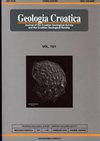Vukomeričke-Gorice地区(克罗地亚中部)上新世Viviparus矿床的矿物组合和物源
IF 1.1
4区 地球科学
Q3 GEOLOGY
引用次数: 5
摘要
活化石床是上新世和更新世早期沉积在湖泊和河流淡水环境(斯拉沃尼亚湖)中的沉积物。在克罗地亚中部的Vukomeričke-Gorice地区进行了详细的实地研究和矿物学、岩石学和化学分析,以确定其成分和来源。Viviparus层的特征是矿物和化学成熟的泥质岩和砂的垂直和横向交换。Pelitic沉积物主要由碎屑石英、方解石、白云石和长石颗粒组成,蒙脱石是最常见的粘土矿物。石英和最具抵抗力的岩屑在砂质碎屑中占主导地位。沉积物的成分表明它们起源于再生造山带,而它们的结构不成熟表明它们的运输距离很短。大部分物质是从下伏的上中新世沉积物中重新沉积而来的,最初来源于阿尔卑斯山。一小部分来源于古近系沉积物、三叠纪碳酸盐岩、基性或酸性岩浆岩和变质岩。Medvednica和žumberak山是最重要的来源地,而较小比例的物质可能来自Moslavačka gora山和Banovina地区。在沉积物的整个垂直分布上,Viviparus层的均匀组成清楚地表明,源区在沉积过程中没有变化。从高山起源的上中新世碎屑碎屑碎屑的结构和组成成熟,到当地起源的Viviparus层的结构未成熟物质的显著变化,是由于先前伸展盆地的压缩和反转,导致潘诺尼亚盆地系统西南部山脉的抬升和侵蚀。本文章由计算机程序翻译,如有差异,请以英文原文为准。
Mineral assemblage and provenance of the Pliocene Viviparus beds from the Area of Vukomeričke Gorice (Central Croatia)
Viviparus beds are sediments deposited in lacustrine and fluvial freshwater environments (Lake Slavonia) during the Pliocene and the earliest Pleistocene. A detailed field study and mineralogical, petrographic and chemical analyses were carried out to determine their composition and origin in the area of Vukomeričke Gorice, Central Croatia. Viviparus beds are characterized by the vertical and lateral exchange of mineralogically and chemically mature pelites and sands. Pelitic sediments consist mainly of detrital quartz, calcite, dolomite and feldspar grains, with smectite as the most common clay mineral. Quartz and the most resistant lithic fragments dominate the sandy detritus. The composition of the sediments indicates their origin from the recycled orogen, while their textural immaturity suggests a short transport distance. Most of the material was re-deposited from the underlying Upper Miocene sediments, originally of Alpine provenance. A lesser proportion originated from Palaeogene sediments, Triassic carbonate rocks, basic or acidic magmatic rocks and metamorphites. The Medvednica and Žumberak Mts. were the most important source areas, while a smaller proportion of the material could have come from the Moslavačka gora Mt. and Banovina region. The uniform composition of the Viviparus beds over the entire vertical distribution of the sediments clearly indicates that the source areas did not change during their deposition. A significant change from the texturally and compositionally mature Upper Miocene clastic detritus of alpine origin, to the texturally immature material of the Viviparus beds of local origin is a consequence of compression and inversion of the previously extensional basin resulting in the uplifting and erosion of the mountains within the SW part of the Pannonian Basin System.
求助全文
通过发布文献求助,成功后即可免费获取论文全文。
去求助
来源期刊

Geologia Croatica
GEOSCIENCES, MULTIDISCIPLINARY-
CiteScore
2.90
自引率
23.10%
发文量
35
审稿时长
>12 weeks
期刊介绍:
Geologia Croatica welcomes original scientific papers dealing with diverse aspects of geology and geological engineering, the history of the Earth, and the physical changes that the Earth has undergone or it is undergoing. The Journal covers a wide spectrum of geology disciplines (palaeontology, stratigraphy, mineralogy, sedimentology, petrology, geochemistry, structural geology, karstology, hydrogeology and engineering geology) including pedogenesis, petroleum geology and environmental geology.
Papers especially concerning the Pannonian Basin, Dinarides, the Adriatic/Mediterranean region, as well as notes and reviews interesting to a wider audience (e.g. review papers, book reviews, and notes) are welcome.
 求助内容:
求助内容: 应助结果提醒方式:
应助结果提醒方式:


